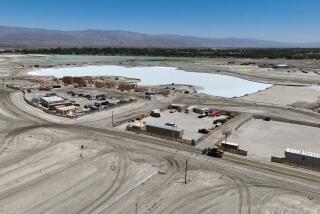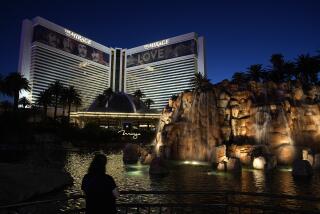Gambling on a Mirage : Gaming: A new $600-million-plus fantasy casino hotel has touched off a building boom in Las Vegas. But will the wager pay off?
- Share via
LAS VEGAS — This town has had its share of notable events in its colorful history, dating back to 1830 when it was discovered by a Mexican scout named Rafael Rivera who stopped here because he found abundant supplies of spring water beneath the desert floor.
In 1931, the city witnessed the arrival of neon signs--the first of many--and in 1967 was jolted by an unprecedented shopping spree during which mysterious financier Howard Hughes acquired four casinos. Another money man, Kirk Kerkorian, marked the end of an era in 1973 when he opened the MGM Grand, the last major casino hotel to be built along this city’s gaudy, storied street known as the Strip.
This week, though, another epoch will begin in this gambling capital when Golden Nugget--whose major stockholder is an impudent deal maker named Stephen A. Wynn--opens the Mirage, a casino hotel whose many frills include a volcano in its front yard.
Costing well over $600 million, the city’s most expensive casino project ever, the Mirage will have a fantasy feel that is part resort, casino, amusement center and zoo. Located on 103 acres of property along the Strip, the complex is so big that it takes more more than a half hour to walk around the property’s perimeter.
“This is Las Vegas’ first 21st Century resort,” said Lee Isgur, entertainment analyst for Paine Webber in New York.
Four years in the making, the Mirage is the talk of this town. So imposing are the 30-story white-and-gold hotel towers that its next-door neighbor, Caesars Palace--the reigning king of glitz and glamour--looks retiring by comparison.
The Mirage’s most visible attraction promises to be a man-made, 54-foot volcano surrounded by water located along the Strip, also known as Las Vegas Boulevard. If it lives up to its billing, the volcano will shoot gas-fired flames 40 feet into the air every few minutes.
Recently, when the volcano was test-fired, it caused a major traffic jam along the Strip. “People just got out of the cars and went over to see what was going on,” one limousine driver said.
Other highlights of the Mirage include: - A 20,000-gallon fish tank behind the check-in desk that is supposed to keep guests amused while waiting in line for their rooms.
- A habitat for white tigers used by famed magicians Siegfried and Roy, whose show will play regularly at the hotel’s 1,500-seat showroom.
- A swimming pool a quarter mile around that has islands with palm trees on them. The pool, which does not open until March, will also have a dolphin habitat nearby.
- A private gambling room, known as a salon prive, for those who bet with $1,000 chips only.
- 3,049 rooms, including 260 suites and, at a cost of up to $1,250 a night, six private bungalows with swimming pools. Regular room rates range from $89 to $129, well in excess of the citywide average.
Scheduled to open Wednesday, the Mirage has already triggered a huge refurbishing boom by nearby competitors scrambling to keep up, as well as a protest by an Australian firm claiming that it already has the rights to the Mirage name. The dispute is now in court.
The Mirage is also leading the way for a new breed of monster-sized casino resorts planned for the Strip that, their promoters say, will broaden the city’s appeal beyond its present base of gambling and conventions. Kerkorian is planning one of the projects at a cost of about $700 million.
The Mirage is very much a creature of Wynn, regarded by some industry insiders as an unguided rocket more driven by ambition and ego than economics. Some analysts believe that the Mirage will fall short of financial expectations.
“It’s going to be a must-see property,” said Marvin B. Roffman, financial analyst in Philadelphia for Janney Montgomery Scott. “The question is: Will it make it financially?”
Roffman and others point out that the Mirage is opening at a time of huge expansion in Las Vegas, while the nation’s economy is in fragile condition and flirting with recession. A recession might be particularly hard on Nevada because the state is so dependent on gaming for its economic health.
“Everybody is nervous that this expansion (in Las Vegas) will turn into a contraction,” said Tim Ozenne, economist in Los Angeles for First Interstate Bank.
“What concerns me,” Roffman said, “is what the economy is going to be like in mid-1990 and beyond. You have to fill up more than 3,000 hotel rooms (at the Mirage) 365 days a year. When the economy is not good, it is dangerous for companies” that are heavily in debt.
Indeed, it was Wynn’s willingness to assume heavy debts that helped him become a major force in the casino industry in the 1980s. He realized his building plans through the financial succor of Michael Milken, the erstwhile junk bond king now under indictment for securities fraud.
Drexel Burnham Lambert, Milken’s former employer, arranged the funding for Wynn’s casinos in Atlantic City and Nevada, including the Mirage. “They made me,” Wynn once told a reporter, referring to Drexel.
Wynn is variously described as creative, mercurial and unorthodox. His ex-wife is a director of Golden Nugget and has an office right next to his at the Mirage. Despite their divorce, they continue to live together.
“He’s my boyfriend and I’m his girlfriend,” said Elaine Wynn, who accompanied her husband here more than two decades ago from the East Coast, where his family had run a bingo parlor.
“Don’t think of him in conventional terms,” said one of his spokesmen.
In an interview, Wynn professed to be “bored” by skepticism about the Mirage’s finances. Later, after nearly two hours of nonstop talking, he allowed that the Mirage will easily be able to pay its bills, which should exceed $1 million a day.
Besides, added Elaine Wynn: “It’s not going to do any good to second-guess ourselves now . “
A confidential financial analysis, which Golden Nugget sent to investors last year, stated that the Mirage will be profitable from the outset and should make more than $50 million by 1995.
Paine Webber’s Isgur is one financial analyst who agrees that the Mirage will be a financial success. He said the hotel would boost Golden Nugget’s earnings to as high as $75 million in 1990. Golden Nugget lost money in 1988 and thus far this year, in part because of heavy expenses associated with the Mirage.
Golden Nugget also owns a casino in downtown Las Vegas and in Laughlin, Nev., 90 miles south of Las Vegas on the Colorado River. Wynn sold Golden Nugget’s casino in Atlantic City in 1987 for the steep price of $440 million.
Wynn said he might sell the Mirage if he were offered at least $1.25 billion, about double what it cost to build. New York real estate developer Donald J. Trump, who owns two casino s in Atlantic City and is building a third, wants to buy or build a casino in Las Vegas, leading to speculation that he might want to buy the Mirage.
“We’re not the second coming,” Wynn said. “It’s only a hotel.”
The Mirage is only one part of an unprecedented building boom that has the Strip clogged with cars and construction crews. Hotel and motel rooms in the Las Vegas area, which now number 64,000, are expected to jump to 75,000 next year and perhaps to 100,000 by as early as the mid-1990s, local experts predict.
“There is a building boom going on all over town,” said Henry Gluck, chairman of Caesars World, which owns and operates Caesars Palace.
Caesars Palace has undertaken an expensive expansion -- expected to cost the company about $250 million -- that includes an enlargement of the casino, a parking garage behind the hotel and an enclosed shopping mall between Caesars and the Mirage. A people mover will also connect the two casino hotels.
Circus Circus Enterprises plans to open a 4,000-room resort next summer known as Excalibur that will have two huge hotel towers bracketing a multilevel entertainment center and casino with the look of a Medieval castle. The resort, whose estimated cost is $260 million to $290 million, should open next June.
Not to be outdone, Kerkorian through his majority-owned MGM Grand is planning a casino hotel and amusement park located diagonally across the Strip from Excalibur. Plans call for a 5,000-room hotel next to a theme park in operation by 1992.
Promoters of Las Vegas contend that the new mega-casinos, including the Mirage, will combine to give Las Vegas an image that is at once more attractive to families and to the jet set.
At the same time, though, the new competition is expected to drive struggling gambling halls out of business.
“There’s going to be a shakeout,” said Glenn S. Schaeffer, chief financial officer of Circus Circus. “The rich will get richer and the poor poorer. You can’t compete today without some kind of (distinct) identity.”
Some also worry that the Las Vegas of the future will be beset by growing urban problems, particularly along the car-clogged Strip. The Mirage alone will bring in nearly 6,000 new workers a day into the most crowded part of town.
“Traffic is . . . one of my biggest worries,” said Saul F. Leonard, a partner for the consulting firm of Laventhol & Horwath. “There could be gridlock.”
More to Read
Sign up for The Wild
We’ll help you find the best places to hike, bike and run, as well as the perfect silent spots for meditation and yoga.
You may occasionally receive promotional content from the Los Angeles Times.






